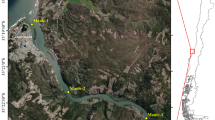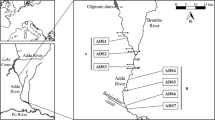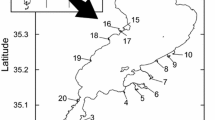Abstract
Construction of two dams in 1958 and 1982 reduced freshwater inflow events to Rincon Bayou, part of the Nueces Delta near Corpus Christi, Texas, USA. Inflow reduction led to a reverse estuary, where low-salinity water flooded the delta on incoming tides and higher salinities were found near the Nueces River. Hypersaline conditions caused by high evaporation rates and low water levels were common during summer in the upper reaches. In October 1995, an overflow diversion channel was created by lowering the bank of the Nueces River to restore inflow events into Rincon Bayou, which is the main stem creek that runs through the center of the Delta. Hypersaline conditions occurred four times from mid-1994 to mid-1997 and only once after mid-1997. Lower, rather than higher, salinity conditions were found after August 1997 in the upper reaches. Benthic faunal recovery was monitored by changes in macrofauna and meiofauna communities. Macrofauna responded to inflow events with increased abundances, biomass, and diversity but decreased during hypersaline conditions. Meiofauna abundance also increased with increasing inflow. Benthic characteristics were different in Rincon Bayou than in a reference site, upstream from introduced inflow. As inflow events have increased due to the diversion, the opportunities for positive responses to increased flow have increased. Although the oveflow channel was filled in at the end of the demonstration project in fall 2000, the City of Corpus Christi reopened the channel in fall 2001 because the ecological benefits were credited toward the state-mandated minimum flow requirement for the Nueces Estuary.
Similar content being viewed by others
Literature Cited
Asquith, W. H., J. G. Mosier, andP. W. Bush. 1997. Status, trends and changes in freshwater inflows to bay systems in the Corpus Christi Bay National Estuary Program Area. Publication CCBNEP-17. Texas natural Resource Conservation Commission, Austin, Texas.
Banse, K. andS. Mosher. 1980. Adult body mass and annual production/biomass relationships of field populations.Ecological Monographs 50:355–379.
Bell, S. S. 1980. Meiofauna-macrofauna interactions in a high salt marsh habitat.Ecological Monographs 50:487–505.
Bureau of Reclamation. 2000. Chapter 3: Hydrography.In Concluding Report: Rincon Bayou Demonstration Project. Volume II: Findings. U.S. Department of the Interior, Bureau of Reclamation. Austin, Texas.
Clarke, K. R. andR. N. Gorley. 2001. PRIMER v5: User Manual/tutorial. Primer-E, Plymouth, U.K.
Clarke, K. R. andR. M. Warwick. 2001. Change in Marine Communities: An Approach to Statistical Analysis and Interpretation, 2nd edition. Primer-E, Plymouth, U.K.
Comín, F. A., J. A. Romero, O. Hernandez, andM. Menéndez. 2001. Restoration of wetlands from abandoned rice fields for nutrient removal, biological community and landscape diversity.Restoration Ecology 9:201–208.
Coull, B. C. andS. S. Bell. 1979. Perspectives of marine meiofaunal ecology, p. 189–216.In R. J. Livingston (eds.), Ecological Processes in Coastal and marine Systems. Plenum Publishing Corp., New York.
Coull, B. C. andM. A. Palmer. 1984. Field experimentation in meiofaunal ecology.Hydrobiologia 118:1–19.
Day, Jr.,J. W., C. A. S. Hall, W. M. Kemp, andA. Yáñez-Arancibia. 1989. Estuarine Ecology. Wiley-Interscience Publications, New York.
Deegan, L. A., J. W. Day, Jr.,J. G. Gosselink, A. Yáñez-Arancibia, G. S. Chávez, andP. Sánchez-Gil. 1986. Relationships among physical characteristics, vegetation distribution and fisheries yield in Gulf of Mexico estuaries, p. 83–100.In D. A. Wolfe (ed.), Estuarine Variability. Academic Press, New York.
Finney, C. M. 1979. Salinity stress in harpacticoid copepods.Estuaries 2:132–135.
Fry, B. 1981. Natural stable carbon isotope tag traces Texas shrimp migrations.Fisheries Bulletin 79:337–345.
Glenn, E. P., C. Lee, R. Felger, andS. Zengel. 1996. Effects of water management on the wetlands of the Colorado River Delta, Mexico.Conservation Biology 10:1175–1186.
Green, R. H. 1979. Sampling Design and Statistical Methods for Environmental Biologists. John Wiley & Sons, Inc., New York.
Hill, M. O. 1973. Diversity and evenness: A unifying notation and its consequences.Ecology 54:427–432.
Jassby, A. D., W. J. Kimmerer, S. G. Monismith, C. Armor, J. E. Cloern, T. M. Powell, J. R. Schubel, andT. J. Vendlinski. 1995. Isohaline position as a habitat indicator for estuarine populations.Ecological Applications 5:272–289.
Kalke, R. D. andP. A. Montagna. 1991. The effect of freshwater inflow on macrobenthos in the Lavaca River Delta and upper Lavaca Bay, Texas.Contributions in Marine Science 32:49–72.
Longley, W. L. (ed.). 1994. Freshwater Inflows to Texas Bays and Estuaries: Ecological Relationships and Methods for Determination of Needs. Texas Water Development Board and Texas Parks and Wildlife Department, Austin, Texas.
Ludwig, J. A. andJ. F. Reynolds. 1988. Statistical Ecology. John Wiley and Sons, New York.
Mannino, A. andP. A. Montagna. 1997. Small scale spatial variation of macrobenthic community structure.Estuaries 20:159–173.
Moffett, A. W. 1970. The Shrimp Fishery in Texas. Texas Parks and Wildlife Department, Austin, Texas.
Montagna, P. A. 1995. Rates of meiofaunal microbivory: A review.Vie et Milieu 45:1–10.
Montagna, P. A., G. F. Blanchard, andA. Dinet. 1995. Effect of production and biomass of intertidal microphytobenthos on meiofaunal grazing rates.Journal of Experimental Marine Biology and Ecology 185:149–165.
Montagna, P. A. andR. D. Kalke. 1992. The effect of freshwater inflow on meiofaunal and macrofaunal populations in the Guadalupe and Nueces estuaries, Texas.Estuaries 15:307–326.
Montagna, P. A. andW. B. Yoon. 1991. The effect of freshwater inflow on meiofaunal consumption of sediment bacteria and microphytobenthos in San Antonio Bay, Texas, USA.Estuarine, Coastal and Shelf Science 33:529–547.
Nixon, S. A., C. A. Oviatt, J. Frithsen, andB. Sullivan. 1986. Nutrients and the productivity of estuarine and coastal marine ecosystems.Journal of the Limnological Society of South Africa 12:43–71.
Riera, P., P. A. Montagna, R. D. Kalke, andP. Richard. 2000. Utilization of estuarine organic matter during growth and migration by juvenile brown shrimpPenaeus aztecus in a South Texas estuary.Marine Ecology Progress Series 199:205–216.
Ritter, M. C. 1999. Benthic succession in a Texas estuary: The influence of hypoxia, salinity, fluctuations, and disturbance frequency. Ph.D. Dissertation, Department of Marine Science, University of Texas at Austin, Port Aransas, Texas.
Ritter, M. C. andP. A. Montagna. 1999. Seasonal hypoxia and models of benthic response in a Texas bay.Estuaries 22:7–20.
SAS Institute, Inc. 1991. SAS/STAT7 User's Guide, Version 6, 4th edition, Volume 2. SAS Institute Inc., Cary, North Carolina.
SigmaPlot. 2000. SigmaPlot 2000 Programming Guide. SPSS Inc., Chicago, Illinois.
Stevens, L. E., J. C. Schmidt, T. J. Ayers, andB. T. Brown. 1995. Flow regulation, geomorphology, and Colorado River marsh development in the Grand Canyon, Arizona.Ecological Applications 5:1025–1039.
Walters, C., L. Gunderson, andC. S. Holling. 1992. Experimental policies for water management in the Everglades.Ecological Applications 2:189–202.
Ward, G. H. 1985. Marsh enhancement by freshwater diversion.Journal of Water Resources Planning and Management 111:1–23.
Ward, G. H. andN. E. Armstrong. 1997. Ambient water, sediment, and tissue quality of the Corpus Christi Bay National Estuary Program Area, present status and historical trends. Publication CCBNEP-23. Texas Natural Resource Conservation Commission, Austin, Texas.
Author information
Authors and Affiliations
Corresponding author
Rights and permissions
About this article
Cite this article
Montagna, P.A., Kalke, R.D. & Ritter, C. Effect of restored freshwater inflow on macrofauna and meiofauna in upper Rincon Bayou, Texas, USA. Estuaries 25, 1436–1447 (2002). https://doi.org/10.1007/BF02692237
Received:
Accepted:
Issue Date:
DOI: https://doi.org/10.1007/BF02692237




